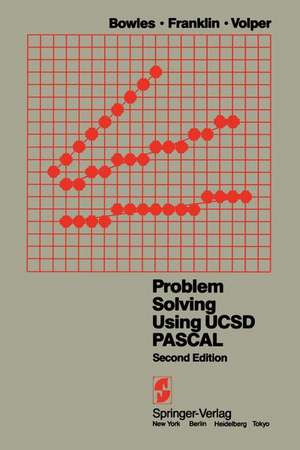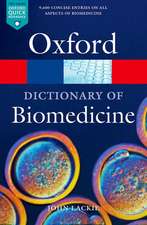Problem Solving Using UCSD Pascal
Autor K. L. Bowles, S. D. Franklin, D. J. Volperen Limba Engleză Paperback – 4 apr 1984
Preț: 391.61 lei
Nou
Puncte Express: 587
Preț estimativ în valută:
74.93€ • 78.45$ • 62.00£
74.93€ • 78.45$ • 62.00£
Carte tipărită la comandă
Livrare economică 05-19 aprilie
Preluare comenzi: 021 569.72.76
Specificații
ISBN-13: 9780387908229
ISBN-10: 0387908226
Pagini: 340
Ilustrații: XI, 340 p.
Dimensiuni: 155 x 235 x 19 mm
Greutate: 0.5 kg
Ediția:2nd ed. 1984
Editura: Springer
Colecția Springer
Locul publicării:New York, NY, United States
ISBN-10: 0387908226
Pagini: 340
Ilustrații: XI, 340 p.
Dimensiuni: 155 x 235 x 19 mm
Greutate: 0.5 kg
Ediția:2nd ed. 1984
Editura: Springer
Colecția Springer
Locul publicării:New York, NY, United States
Public țintă
ResearchCuprins
0. Introduction.- 1. Problem Examples.- 2. Algorithms, Data, and Programs.- 3. The Choice of Pascal as our Programming Language.- 4. Equipment — Micro, Mini, and Maxi Computers.- 5. Graphic Display Devices.- 6. Organization of the Book.- 7. Computer Jargon.- 8. The Goal Statements.- 9. Study Habits.- 1. Getting Started.- 1. Goals.- 2. Commands to the Computer..- 3. Drawing Simple Pictures with Commands.- 4. A Pascal Program Using the Turtle.- 5. Modifying a Program with the Editor.- 6. Running the Modified Program.- 7. Disk Library and Workfile.- 8. Syntax Diagrams.- 9. Syntax for and .- 10. Sample Program Using ’s.- 2. Procedures and Variables.- 1. Goals.- 2. Background.- 3. Procedures.- 4. Calling One Procedure from Another.- 5. Parameters.- 6. Syntax for Procedures.- 7. Variables.- 8. Syntax for Variables.- 9. Preliminaries on Arithmetic Expressions.- 10. Working with STRING variables.- 11. Built-in Procedures and Functions for Strings.- 12. Sample Programs Using Strings.- 3. Control Structures 1.- 1. Goals.- 2. Background.- 1. The WHILE Statement.- 2. The IF Statement.- 3. Two-way IF Statement, Syntax for IF Statements.- 4. Syntax of Boolean Expressions.- 5. Sample Program — PLOTNAME.- 4. Control Structures II.- 1. Goals.- 2. Background.- 3. The FOR Statement.- 4. The REPEAT Statement.- 5. The CASE Statement.- 6. Boolean Variables.- 7. Hints on Boolean Expressions and IF Statements.- 8. Note on Indentation.- 5. More on Procedures — Scope.- 1. Goals.- 2. Background.- 3. Scope of Variable Identifiers.- 4. Nested Procedures.- 5. Case Study — Using Nested Procedures.- 6. Declaring Your Own Functions.- 7. Variable Parameters.- 8. Recursive Procedures.- 9. Misuses of Recursion in Pascal.- 10. Applications of Recursion.- 6. Handling Complex Program Structure.-1. Goals.- 2. Background.- 3. What is an Algorithm?.- 4. Level of Detail.- 5. Structure Diagrams.- 6. Progressive Development of Algorithms.- 7. Structure Diagrams of some Sample Programs.- 8. Solving a Problem based on Conceptual Description.- 9. Three Challenging Problems.- 7. Data Representation.- 1. Goals.- 2. Background.- 3. Character Encoding.- 4. Arithmetic Expressions Assignment of Value.- 5. Integer Representations.- 6. Sample Program — Decimal to Binary Conversion.- 7. Real Number Representation.- 8. Rounding Error.- 9. Sample Program Converge.- 10. Random Numbers.- 8. Input and Output.- 1. Goals.- 2. Background.- 3. Differences Among Input/Output Systems.- 4. READ and READLN Statements.- 5. EOF and EOLN.- 6. File Identifiers: INPUT, OUTPUR and KEYBOARD.- 7. Sample Program AVERAGE.- 8. Sample Program MAKECHANGE.- 9. Sample Program DENOISE.- 10. Sample Program DEVOWEL.- 11. Sample Program DATECHECK.- 12. TEXT files.- 9. Basic Data Structures — I. Arrays.- 1. Goals.- 2. Background.- 3. Subscripted Variables.- 4. Declaration of ARRAY Variables.- 5. Using Arrays of One Dimention.- 6. Packed Character Arrays — Two Dimensions.- 7. Row and Column Sums — Crossfooting.- 8. Three or More Dimensions.- 9. More on Indexing..- 10. Basic Data Structures — II. Sets — Types.- 1. Goals.- 2. Background.- 3. Enumerated Types.- 4. Declaring Your Own Types.- 5. Subrange Types.- 6. Sets.- 7. Sample Program FOODSETS.- 8. Sample Program SETDEMO.- 9. Using Sets with Characters.- 11. Basic Data Structures — III.. Records.- 1. Goals.- 2. Background.- 3. Sample Program CLASSDATA.- 4. The WITH Statement.- 5. Sample Program STURECORD.- 12. Pointers.- 1. Goals.- 2. Background.- 3. Static and Dynamic Variables.- 4. Declaring pointers.- 5. Creating a dynamic variable.- 6.Records with pointers.- 7. Linked lists.- 8. Comparison of ponters.- 9. Summary of pointer operations.- 10. SPORTSCORE2 solved with pointers.- 13. Searching.- 1. Goals.- 2. Background.- 3. Review of Problem Solving Approach.- 4. Linear Search.- 5. Binary Search.- 6. Recursive Binary Search Algorithm.- 14. Sorting — I. Simple Algorithms.- 1. Goals.- 2. Background.- 3. Insertion Sort.- 4. Bubble Sort.- 5. Merging.- 15. Sorting — II. QUICKSORT.- 1. Goals.- 2. Background.- 3. Description of Quicksort.- 4. Improving on Bad Median Guesses.- 5. Recursive Structure Diagram.- Appendix A — Differences of UCSD’s Pascal.- Appendix B — Glossary of Computer Jargon.- Appendix C — Built-in Procedures and Functions.- Appendix D — The UCSD Pascal System.- Appendix E — Syntax Diagrams.- Appendix F — ASCII.






